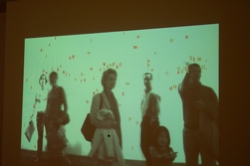Participation
Nov 15, 2004 · peterb · 2 minute readPhoto
If you’re able to borrow someone’s child for a few hours, you should visit the Pittsburgh Children’s Museum. Although their web site is vile, the installations at the museum are nothing short of superb. Nearly everything in the museum is interactive, interesting, and playful in visual, aural, or tactile ways.
[ ](/weblog/imag
es/articles/DCP_1272.JPG)
](/weblog/imag
es/articles/DCP_1272.JPG)
There’s a studio space where you, can make paper, silkscreen prints, paintings, or pottery. There are interesting interactive visual exhibits like the one pictured to the left. There’s a floor with large pools, fountains, and lots of PVC pipe plumbing equipment to let you build little microinstallations of your own. There’s my favorite section, the garage, with a car, some kinetic sculptures, a million switches, dials, and lights, and a small workshop with intermittent demos and lessons in woodworking and electronics. It’s somewhat sad that this is better than most of the museums I’ve been to that view adults as their primary audience, particularly with respect to the art installations. The idea that art can only be playful when it’s targeted at children is depressing. That’s not to say that art must always be playful, but seriously: when was the last time you went to an art exhibition and left with a smile on your face?
The exhibit I photographed above is a great little example. It’s “just” a video projector showing an image of the people passing by against the wall. Various letters, in several colors, cascading down from the top of the screen. The exhibit engages viewers on different levels. Many people just walk by and look at themselves, wave, smile, or point. Others soon notice that the letters, through some clever programming, “land” on surfaces that are projected. Some people start playing with this; the woman in the center of the photo spent 5 solid minutes doing little soccer “headers,” bouncing a letter off of her forehead. Another man realized that the letters weren’t random – they spell a message, Different viewers seek out different strategies for figuring out what it says. I was partial to sticking out an arm and letting the letters land on it; an older gentleman enjoyed walking from left to right and reading the message one syllable at a time.
To know what it says, you’ll have to go visit the museum yourself.